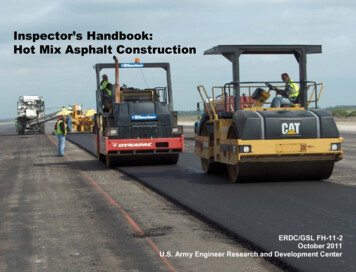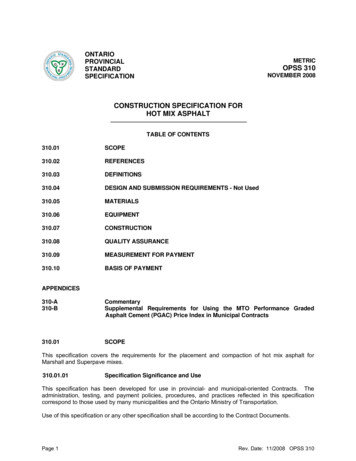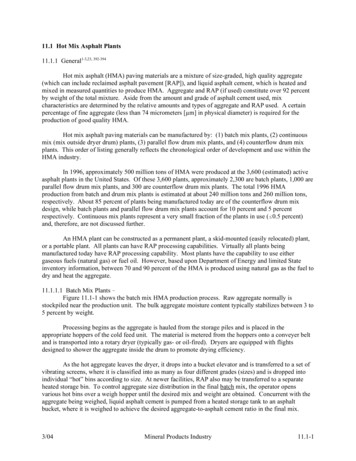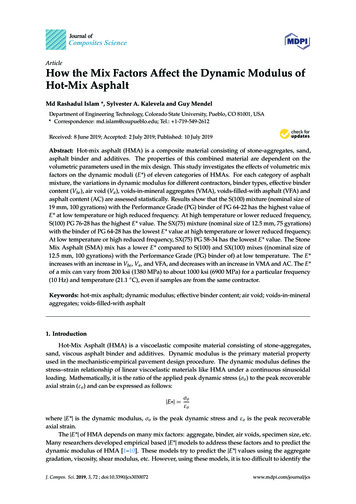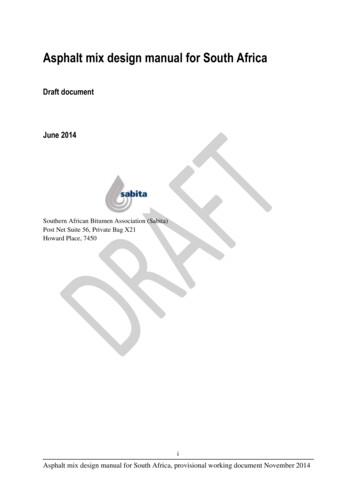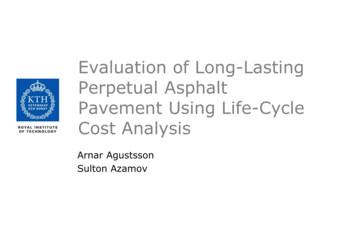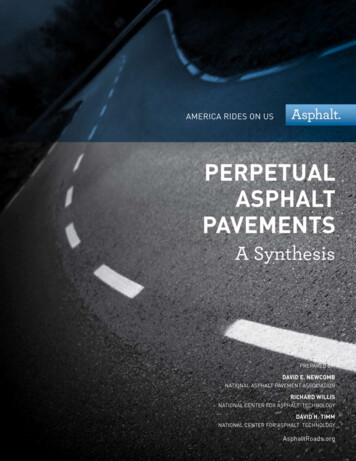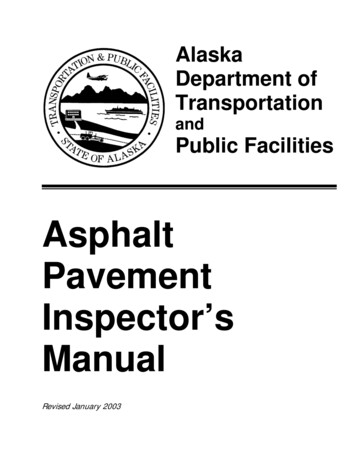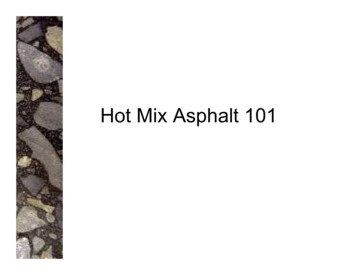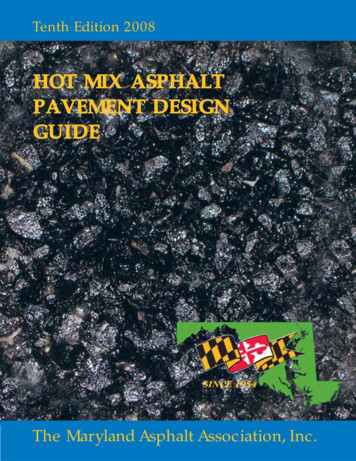
Transcription
Tenth Edition 2008HOT MIX ASPHALTPAVEMENT DESIGNGUIDEThe Maryland Asphalt Association, Inc.
Requirementsfor Successful AsphaltPavement Construction123GOOD PLANNING4GOOD MAINTENANCEGOOD DESIGNGOOD CONSTRUCTIONA) MaterialsB) SubgradeC) Workmanshippublished forMaryland Asphalt Association, Inc.2408-G Pepper Mill Drive, Glen Burnie, MD 21061410-761-2160 Fax 410-761-0339Editor: Brian DolanAuthor: Brian Dolanprinted byE. John Schmitz & Sons, Inc.Sparks, MD 21152410-329-3000 Fax 410-771-4342published byP/T Enterprises, Inc.Fallston, MD 21047410-879-7606 Fax 410-893-5721
INTRODUCTIONThis guide is provided by the Maryland Asphalt Association as a tool for owners, architects, engineers and developers whenpreparing plans and specifications for pavements to be constructed in Maryland.The guide is not intended to be used as a substitute for professional asphalt pavement design by competent engineers usingspecific traffic and soils information. By necessity this manual uses generalizations and simplifications; however, the use of thesedesigns and specifications, together with proper construction controls, will provide users with economic and satisfactorypavements that will provide good performance with relatively little maintenance.The tenth edition of this guide has been prepared in order to bring designers information on the current Maryland State HighwayAdministration Specifications and to incorporate the latest knowledge, techniques and technology that have beendeveloped in asphalt pavement construction over the past several years. This publication is not intended to set standards orregulations. The roadway typical sections are Perpetual Pavements and have been verified using the Per RoadFlexible Perpetual Design & Analysis Software.HOT MIX ASPHALTWHAT IS HOT MIX ASPHALT?Hot mix asphalt may be referred to by several names. Indifferent sections of the state it may also be referred to asbituminous concrete, hot plant mix, asphalt concrete,blacktop or Superpave.Hot mix asphalt is composed of aggregate bound togetherinto a solid mass by asphalt cement. The aggregates totalninety-three (93) to ninety-seven (97) percent by weight ofthe total mixture and are mixed with three (3) to seven (7)percent asphalt cement. It is manufactured in a centralmixing plant where the asphalt and aggregates are heated,properly proportioned, and mixed. The completed pavingmixture is hauled by trucks to the mechanical spreader whereit is placed in a smooth layer and compacted by rollers whilestill hot. (Hot mix asphalt may be placed by hand when it isimpractical to use a paver.)Asphalt pavements are constructed of one or more coursesof hot mix asphalt placed directly on the subgrade or ona subbase.HOT MIX ASPHALT SPECIFICATIONSADVANTAGES OF HOT MIX ASPHALT1. VersatilityHot mix asphalt pavements can be designed tohandle virtually any traffic loading, soils andmaterials, and can be used to salvage old pavementsas well as to build new ones.Phased construction can easily be incorporated.2. EconomyHot Mix Asphalt Pavements are: economical to construct may be constructed rapidly and are immediatelyready for use may be recycled require minimal maintenance provide outstanding performance3. HMA pavements are not affected by ice controlchemicals.4. Building and site esthetics are enhanced.5. Traffic noise is minimized when HMA pavementAll work involving hot mix asphalt pavements and resurfacingcan be covered by using the Maryland State HighwayAdministration July 2008 Standard Specifications forConstruction and Materials in conjunction with the typicalsections that follow.is used.6. Pavement striping is highly visible on the darkcolored surface.7. HMA is a flexible-type pavement.HOT MIX ASPHALT RESURFACINGResurfacing is the placing of one or more courses of hot mixasphalt over an existing hard surface pavement. This is themost often used means for salvaging and extending theservice life of older deteriorating pavements.1
SUPERPAVESuperpave is a state of the art paving system which our industry and the state of Maryland embraced inthe late 1990’s. Marshall mixes are no longer readily available and should be replaced with the appropriate Superpave specifications.There are four important Superpave parameters which the owner must specify in order to insure theproper design. These parameters include the type of liquid asphalt which, in all but the most unusualcircumstances should be PG 64-22; the compaction level should be “N Design 50” or Level 1 for allapplications except minor or principal arterial streets. The next two parameters go hand in hand andshould always be considered together. Aggregate size and lift thickness are inseparable. All mix selectionsshould allow for at least 4 times the nominal maximum aggregate size for the desired lift thickness. Thismeans 9.5mm aggregate surfaces should be a minimum of 1-1/2” thick.Please consult with the Maryland Asphalt Association for guidance in specifying the proper superpavespecification for your individual project.SPECIFICATIONS FORHOT MIX ASPHALTThere are a wide variety of hot mix asphalt compositions usedin Maryland that vary from fine to coarse in size andgradation. Furthermore, Maryland hot mix asphalt mixturesutilize different aggregates or combinations of aggregates, theprincipal types being crushed stone, sand, gravel, bank rungravel, roofing shingles and recycled asphalt pavement.Economics require the use of locally available aggregates.The most widely used hot mix asphalt specifications inMaryland are those contained in the State HighwayAdministration Standard Specifications for Constructionand Materials dated July 2008 including revisionsand additions.The Maryland Asphalt Association recommends the use ofthese specifications.BASE DESIGNATIONS19 MM SuperpaveGenerally a minimum lift thickness of 3" is recommended.Aggregate sizes of the mix design should be checked priorto use in thinner lifts.12.5 MM SuperpaveGenerally a minimum lift thickness of 2" is recommended.Aggregate sizes of the mix design should be checked priorto use in thinner lifts.SURFACE DESIGNATIONS9.5 MM SuperpaveThis surface mix is recommended for most surfaceapplications.Recommended minimum lift thickness 11/2".4.75 MM SuperpaveThis mix is designed primarily for thin lift leveling orcorrecting minor deviations. It is a fine mix that can beplaced in lifts as thin as 1/2". It should not be placed inlifts exceeding 1" and should not normally be specifiedas a final wearing course for structural repairs orresurfacings.SMA (Stone Matrix Asphalt)This is a high stability mix designed for specific conditionssuch as high volume Interstate Highways.2
ASPHALT PAVING MIXTURESThe pavement design requires the proper hot mix asphaltpaving mixtures for the base and surface pavements.It is important that a Job Mix Formula for the pavingmixture be established for and approved by the engineer.A reputable hot mix asphalt producer, providing standardmixes, can readily furnish the engineer with a written JobMix Formula.The asphalt mixtures referred to in this manual are MarylandState Highway Administration Job Mix Designs which arereadily available throughout Maryland and have proventhrough extensive use to have all of the desirablecharacteristics of good asphalt pavements.SPECIFICATIONSMaryland State Highway Administration StandardSpecifications for Construction and Materials, datedJuly 2008, including revisions and additions,contain the following sections for Hot Mix Asphalt Pavementand Asphalt Cements and Hot Mix Asphalt:Section 504—Hot Mix Asphalt PavementSection 505—Hot Mix Asphalt PatchesSection 508—Milling Existing Hot Mix AsphaltPavementSection 901—AggregatesSection 904—Performance graded asphalt bin &HMASection 915—Production PlantsSection 915.02—Hot Mix Asphalt PlantsTACK COATENGINEERING SERVICESA tack coat of asphalt (usually emulsified asphalt) is appliedto ensure bond between the existing surface and the asphaltoverlay. It should be applied in an even, thin coat at a rate ofapplication of .05 gallons per square yard with a tolerance of.01 gallons per square yard. Excessive tack coat can causeslippage or can flush to the surface. All longitudinal andtransverse joints shall be properly tacked.The Maryland Asphalt Association welcomes the opportunityto work with architects, consulting engineers, public agencyofficials, owners, and industry engineers in the preparation ofpavement specifications, construction details and constructioncontrols toward the end of quality asphalt pavementinstallations. The Association has professional engineeringservices available for this purpose. The Associations addressand telephone number appear on the back cover. Othersources where information and guidance on asphalt pavementconstruction may be obtained are:SUBGRADE SPECIFICATIONSTopsoil, large rocks and other types of low quality, unsuitablesoil shall be removed and replaced. The subgrade must beproperly shaped to the desired sections and elevation andshall be compacted so that it is firm, hard and unyielding. Afirm and unyielding subgrade is essential for good pavementconstruction. The Subgrade shall be compacted to 95% ofdry weight density as determined by AASHTO DesignationT-18O, Method C or D as applicable. (Note:There are areas inMaryland where, due to the type of soil, it is not possible toattain 95% of dry weight density using the T-180 Method. Inthese areas the compaction requirements shall be 95% of thedry weight density as determined by AASHTO DesignationT-99 Method.) To prevent growth of weeds, the subgradeshould be treated with an approved herbicide. (See NAPAPublication IS-51)National Asphalt Pavement Association5100 Forbes BoulevardLanham, Maryland 20706-4413(301) 731-4748 FAX(301) 731-4621The Asphalt InstituteCarlos RosenbergerPO Box 3372 E. Harrisburg St.Dillsburg, PA. 17019717-432-5965The Asphalt InstituteP.O. Box 14052Lexington, Kentucky 40512-4052859-288-4960ESTIMATING QUANTITIESFor a cursory estimate of the quantity of material required,use—1 ton of hot mix asphalt covers 17 square yards, l" thick.A modern hot mix asphalt facility provides highproduction, good quality mixes (including recycledasphalt pavement if desired) while meeting stringentair quality standards.3
Recommended Mix DesignsMAA Chart 1Low Volume Design LevelRecommendedCompacted ThicknessAggregate SizeBinder TypeCompaction LevelSurface9.5mmPG64-2250 gyrations1.5”Base12.5mm19mmPG64-22PG64-2250 gyrations50 gyrations2”3”Aggregate SizeBinder TypeCompaction LevelSurface9.5mmPG64-2250 gyrations1.5”Base12.5mm19mmPG64-22PG64-2250 gyrations50 gyrations2”3”Aggregate SizeBinder TypeCompaction Level9.5mm9.5mmPG64-22PG76-2265 gyrations65 gyrations1.5”1.5”9.5mm SMA12.5mm SMAPG76-22PG76-2280 gyrations80 gyrations1.5”2”12.5mm19mmPG64-22PG64-2265 gyrations65 gyrations2”3”Minor Arterial Design LevelHigh Volume Design LevelSurfaceBaseChart 1: Recommended Mixes for Normal HMA Applications (Proposed compaction levels based on NCHRP 9-9 levels @ 4% Per Voids)4
MAA Chart 2TrafficDesignationEquivalent SingleAxle LoadingsLow 300,000 ESAL’s Roadways with very light traffic volumes such as local roads, countyroads, and city streets where truck traffic is prohibited or at minimum. Traffic considered local in nature, not regional, or interstate. Special purpose roadways serving recreational sites or areas.Moderate300,000 to 10,000,000ESAL’s Most local roadways. Two-lane, multilane, divided, and partially or completely controlledaccess roadways. Medium to highly trafficked city streets, state routes, U.S. highways,and some rural interstates.High 10,000,000 ESAL’s Two-lane, multilane, divided, and partially or completely controlledaccess roadways. Medium to highly trafficked city streets, state routes, U.S. highways,and some rural interstates. Truck-weighing stations or truck-climbing lanes on two-lane roadways.Typical Roadway ApplicationsChart 2: Traffic VolumesDRAINAGEPAVEMENT DESIGNThe design of a hot mix asphalt pavement requires someknowledge of the following:TRAFFICDRAINAGESUBGRADE SOILS SUPPORTTRAFFICAsphalt pavements must be designed using the propernumber and weight of axle loads expected during a givenperiod of time to insure adequate pavement performance.Of primary concern is heavy truck traffic. Pavement life canbe significantly affected by truck traffic, therefore, the weightand volume of the heaviest traffic is a principal factor inpavement design. The following traffic assumptions havebeen made for the purposes of providing typical pavementsections for the following:Proper drainage is imperative in the design and constructionof hot mix asphalt pavements.Where high water tables occur or where water mayaccumulate in low areas, consideration must be given tosubsurface drainage. The installation of underdrains and/orinterceptor drains may be required to prevent theaccumulation of water beneath the pavement structure.Good surface drainage is also essential. A minimum slope orcrown of 1.5% per foot is recommended. The roadwayshoulder or adjacent ground should be graded so that surfacedrainage runs away from the pavement and does not stand onthe pavement's edge.On large parking lots, sloped sections, catch basins, and stormdrains may be necessary for proper drainage.TABLE ISoil Classification Strengths:TYPICAL PAVEMENT SECTION 2—Residential DriveEssentially limited to passenger cars.TYPICAL PAVEMENT SECTION 3—Parking Lots & Residentialor Light Duty Streets present and future traffic limited topassenger cars plus normal service trucks.TYPICAL PAVEMENT SECTION 4—Minor Arterial & LightIndustrial Streets present and future traffic limited to amedium duty classification which includes some heavytruck and bus traffic.TYPICAL PAVEMENT SECTION 5—Principal Arterial,Commercial or Industrial Roads present and future trafficis a heavy duty classification.5
MAA Chart 3R ValueCaliforniaBearing RatioHighway SoilClassificationGreater than 80Greater than 70A-1GW, SW, GP, GMGood55 to 8020 t
Hot mix asphalt may be referred to by several names. In different sections of the state it may also be referred to as bituminous concrete,hot plant mix,asphalt concrete, blacktop or Superpave. Hot mix asphalt is composed of aggregate bound together into a solid mass by asphalt cement. The aggregates total ninety-three (93) to ninety-seven (97) percent by weight of the total mixture and are .File Size: 592KBPage Count: 20


